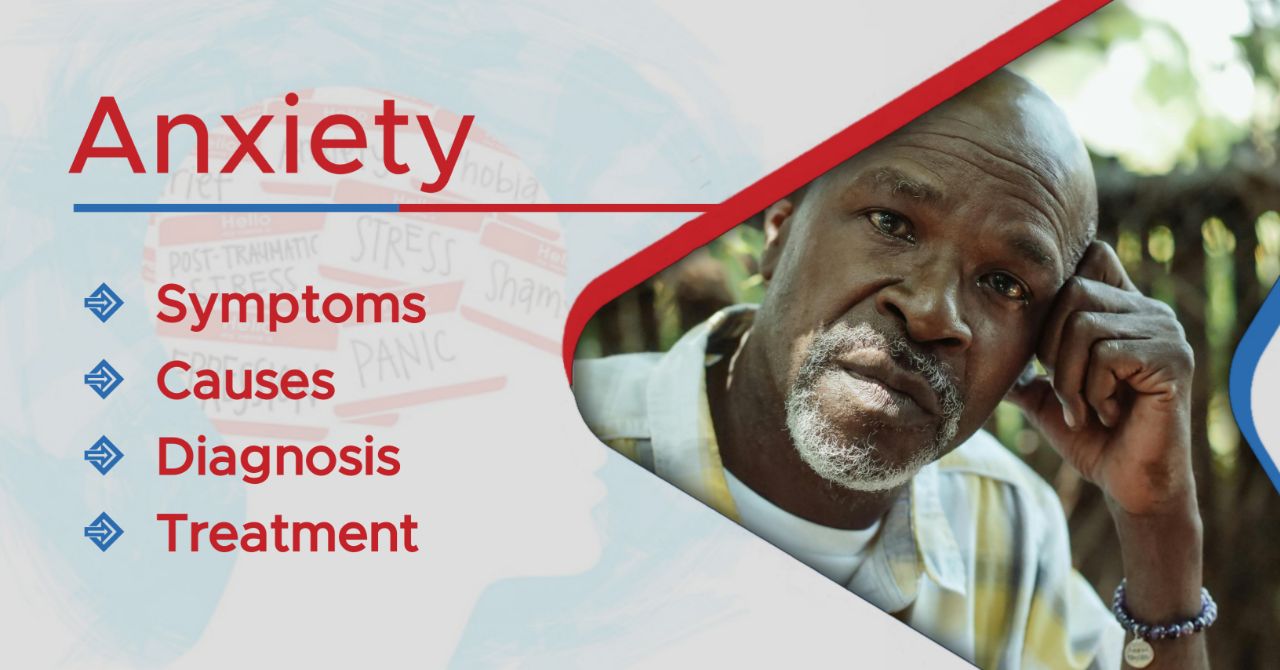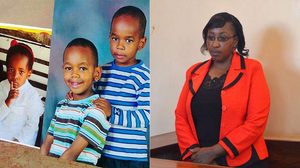
Anxiety
Table of Contents
What is Anxiety? (The Basics)
Reading Time: 22min
At its core, anxiety is a fundamental and universal human experience. It is crucial to distinguish between the everyday anxiety that everyone feels and an anxiety disorder, which is a medical condition.
Normal Anxiety vs. an Anxiety Disorder
Everyone feels anxious at times. This normal anxiety is a natural reaction to stress or perceived danger. It is typically proportionate to the situation, temporary, and can even be helpful. It sharpens our focus before a big presentation, makes us study for an exam, or urges us to brake quickly to avoid a car accident. It’s a signal that alerts us, then fades away when the situation passes.
An anxiety disorder, however, is different. It is characterized by chronic, excessive worry that is disproportionate to the actual circumstances. The anxiety is persistent, often lasting for months, and significantly interferes with daily activities, work, school, and relationships. Where normal anxiety is a helpful signal, an anxiety disorder is a constant, disruptive alarm that goes off when there is no real fire.
The "Fight-or-Flight" Response
This feeling of anxiety originates from our body's innate "fight-or-flight" response—a survival mechanism hardwired into our biology. When faced with a threat, this system floods the body with adrenaline and cortisol, triggering physiological changes like a rapid heartbeat, quickened breathing, and heightened senses. These changes prepare us to either confront the danger or escape from it.
This system is essential for survival. However, with an anxiety disorder, this alarm system can become dysregulated. It becomes overly sensitive, activating too frequently, too intensely, or in situations that are not truly threatening. It’s like a highly sensitive car alarm that blares not only when someone breaks a window but also when a truck drives by.
Key Message: A Common and Treatable Condition
It is vital to understand that an anxiety disorder is a real medical condition with a strong biological basis, influenced by genetics, brain chemistry, and life experiences. It is not a character flaw, a sign of personal weakness, or something one can simply "get over" by willing it away. Anxiety disorders are among the most common mental health conditions globally, affecting millions of people from all walks of life. Recognizing it as a legitimate health issue is the first step toward seeking effective, evidence-based treatment and reducing the stigma that often surrounds it.
Signs and Symptoms: How Anxiety Manifests
Anxiety is more than just a feeling of worry; it is a full-body experience that can impact a person emotionally, physically, cognitively, and behaviorally. Its symptoms often create a feedback loop, where one symptom can exacerbate another, making the experience feel overwhelming.
Emotional Symptoms: The Inner Landscape
The emotional core of anxiety is a persistent and often disproportionate sense of apprehension. This goes beyond temporary nervousness and can include a constant, generalized feeling of dread, as if something bad is about to happen. Individuals often report feeling perpetually "on edge," irritable, or tense. This emotional state is not easily quieted by logic or reassurance, as the nervous system is operating under a heightened sense of alert.
Physical Symptoms: The Body's Alarm System
Anxiety actively engages the body's primal "fight-or-flight" response, leading to a cascade of physical sensations. These are real physiological reactions, not imagined. Common symptoms include a rapid heart rate (palpitations), sweating, trembling or shaking, and shortness of breath or a feeling of being smothered. Dizziness, lightheadedness, and gastrointestinal distress like stomachaches or nausea are also frequent. Because the body is in a state of high alert, chronic muscle tension and profound fatigue are very common, as the body is expending immense energy even while at rest.
Cognitive Symptoms: The Anxious Mind
Anxiety powerfully affects thought processes. The mind may race with worried thoughts, making it difficult to concentrate on tasks, follow conversations, or remember information—often described as "blanking out." A key cognitive feature is a persistent tendency to anticipate the worst-case scenario (catastrophizing). Some individuals may also experience intrusive thoughts, which are unwanted and distressing ideas or mental images that can feel difficult to control.
Behavioral Symptoms: Actions Driven by Fear
In an effort to manage intense anxiety, individuals often adapt their behavior, typically through patterns of avoidance. This involves steering clear of people, places, or situations that are perceived as potential triggers for anxiety. While this provides short-term relief, it reinforces the fear long-term and can severely restrict one's life. Other behavioral symptoms can include compulsive, repetitive actions performed to neutralize anxiety (e.g., checking, counting), or repeatedly seeking reassurance from others to alleviate distress.
Common Types of Anxiety Disorders
While often spoken of as a single condition, anxiety manifests in several distinct forms, each with its own unique pattern of fears and symptoms. Understanding these differences is key to accurate diagnosis and effective treatment.
Generalized Anxiety Disorder (GAD)
GAD is characterized by chronic, excessive, and difficult-to-control worry about a wide range of everyday things—from health and finances to minor responsibilities and world events. This isn't just everyday stress; it's a persistent state of "what if?" that feels overwhelming and disproportionate. The worry is often accompanied by physical symptoms like restlessness, fatigue, and muscle tension. People with GAD may find it hard to shake the feeling that something bad is about to happen, even when there is no clear reason for concern.
Social Anxiety Disorder (Social Phobia)
This disorder involves an intense, persistent fear of social or performance situations driven by a deep-seated dread of being judged, embarrassed, or humiliated. It extends far beyond shyness. For those with social anxiety, everyday interactions like speaking in a meeting, eating in public, or even making small talk can trigger intense fear and avoidance. The worry is focused on negative evaluation by others, leading to significant distress and often causing individuals to isolate themselves.
Panic Disorder
Panic Disorder is defined by the experience of recurrent, unexpected panic attacks—sudden, intense surges of fear or discomfort that peak within minutes. These attacks involve severe physical symptoms like a racing heart, chest pain, shortness of breath, dizziness, and a feeling of losing control or "going crazy." A key feature of Panic Disorder is anticipatory anxiety—a powerful fear of having future attacks. This fear often leads individuals to avoid places or situations where attacks have occurred before.
Specific Phobias
A specific phobia is an intense, irrational, and persistent fear of a specific object, activity, or situation that poses little to no actual danger. Common examples include fear of heights (acrophobia), flying (aviophobia), needles (trypanophobia), or animals like spiders (arachnophobia). The immediate anxiety response is so strong upon exposure to the feared stimulus that individuals will go to great lengths to avoid it, even if they know their fear is unreasonable.
Agoraphobia
Agoraphobia involves a marked fear or anxiety about being in situations where escape might be difficult or help might not be available if panic-like or embarrassing symptoms occur. This often includes fears of using public transportation, being in open or enclosed spaces, standing in line, or being outside of the home alone. The fear is often rooted in the thought that something terrible could happen and there would be no way to get help or leave easily. In severe cases, this can lead to individuals becoming housebound.
Separation Anxiety Disorder
While often associated with children, this disorder can affect adults as well. It involves excessive and developmentally inappropriate fear or anxiety about being separated from those to whom an individual is attached. The person worries excessively that harm will befall their attachment figures or that something will happen to lead to permanent separation. This leads to reluctance to be alone and avoidance of situations that involve separation, which can significantly impair the ability to engage in work, school, or independent activities.
Causes and Risk Factors
Understanding what causes anxiety disorders can help demystify the experience and reduce feelings of self-blame. It is crucial to know that there is no single cause. Instead, anxiety disorders typically develop from a complex interplay of several factors, best explained by the biopsychosocial model. This means biological, psychological, and environmental factors all contribute to an individual's vulnerability.
Biological Factors (The Body's Predisposition)
These are the inherent, often genetic and physiological, elements that can increase susceptibility.
- Genetics: Anxiety can run in families, suggesting a heritable component. If you have a close family member with an anxiety disorder, you may have a higher genetic risk of developing one. This is not a guarantee, but a predisposition.
- Brain Chemistry and Circuitry: Neurotransmitters are chemical messengers in the brain (like serotonin, GABA, and norepinephrine) that help regulate mood and fear responses. An imbalance in these systems can contribute to anxiety. Furthermore, brain imaging studies show that areas of the brain involved in fear and emotion (like the amygdala) can be overactive in people with anxiety disorders.
- Personality/Temperament: Individuals who are naturally more inhibited, sensitive, or prone to negative affect in childhood may be at a higher risk.
Environmental Factors (Life Experiences)
These are the external events and circumstances that can trigger or exacerbate anxiety.
- Stressful Life Events: Ongoing stress from work, finances, relationships, or a significant life change (like a divorce or bereavement) can be powerful triggers.
- Trauma: Exposure to traumatic events, especially in early childhood, is a significant risk factor. This includes abuse, neglect, or witnessing violence.
- Childhood Experiences: Learned behaviors also play a role. Growing up in a environment where the world was portrayed as dangerous, or observing family members who were frequently anxious, can teach a person to respond to challenges with fear and worry.
Psychological Factors (Mind and Mentality)
This involves an individual's mental health history and their learned patterns of thinking and coping.
- Co-existing Mental Health Conditions: Having another mental health disorder, such as depression, greatly increases the likelihood of also developing an anxiety disorder. The symptoms often overlap and can fuel one another.
- Coping Style: The way a person typically handles stress is critical. Those who have not learned adaptive coping strategies or who tend to use avoidance (rather than problem-solving or seeking support) to manage distress are more vulnerable. Cognitive patterns, such as a tendency to catastrophize or perceive neutral events as threatening, also sustain anxiety.
How is it Diagnosed?
Receiving a diagnosis for an anxiety disorder is a structured process designed to thoroughly understand your experience and ensure accuracy. It is not based on a single test but on a collaborative assessment between you and a healthcare professional.
The Diagnostic Process: A Collaborative Conversation
The journey typically begins with a consultation, often with your primary care doctor or a mental health specialist like a psychiatrist or psychologist. The initial and crucial step is to rule out other medical conditions that can mimic anxiety symptoms. For instance, thyroid disorders, heart conditions, or vitamin deficiencies can cause physical sensations like a rapid heartbeat, sweating, and tremors. A doctor may perform a physical exam or order lab tests to confidently eliminate these as potential causes. This ensures that your symptoms are correctly attributed to an anxiety disorder and not an underlying physical illness.
The Assessment: Using Standardized Criteria
Once other medical causes are ruled out, a clinician will conduct a detailed psychological assessment. This involves a thoughtful conversation where they will ask you about your thoughts, feelings, behaviors, and the specific physical symptoms you experience.
To ensure consistency and accuracy, professionals rely on two key tools:
- Standardized Screening Questions: These are validated questionnaires (such as the GAD-7 for generalized anxiety) that help quantify the severity and frequency of your symptoms. They provide an objective measure to guide the clinician's judgment.
- The DSM-5 Criteria: The Diagnostic and Statistical Manual of Mental Disorders, Fifth Edition (DSM-5) is the standard reference manual used by clinicians. It provides a specific checklist of symptoms, their duration, and the level of impairment required for a formal diagnosis of each type of anxiety disorder.
For example, a diagnosis of Generalized Anxiety Disorder (GAD) requires excessive anxiety occurring more days than not for at least six months, difficulty controlling the worry, and the presence of additional symptoms like restlessness or fatigue. This structured yet compassionate process ensures that a diagnosis is not made lightly. It is a careful evaluation aimed at fully understanding your unique situation, which is the essential first step toward creating an effective and personalized treatment plan.
Treatment and Management Strategies
The good news about anxiety disorders is that they are among the most treatable mental health conditions. Effective management rarely relies on a single solution; instead, it typically involves a multi-faceted approach tailored to the individual's specific needs. The goal is not just to reduce symptoms but to build long-term skills for resilience and well-being.
Psychotherapy: Retraining the Brain and Body
Psychotherapy, or talk therapy, is a cornerstone of anxiety treatment. The most extensively researched and effective form is Cognitive Behavioral Therapy (CBT). CBT operates on the understanding that our thoughts, feelings, and behaviors are interconnected. It teaches practical skills to:
- Identify and challenge distorted, anxious thought patterns (e.g., catastrophizing).
- Change behavioral responses by gradually facing feared situations through exposure therapy, which reduces avoidance and builds confidence.
- Develop healthier coping mechanisms for managing stress.
Medication: Correcting Chemical Imbalances
Medication can be a highly effective tool, especially for moderating severe symptoms to allow psychotherapy to be more effective.
- SSRIs (Selective Serotonin Reuptake Inhibitors) and SNRIs (Serotonin-Norepinephrine Reuptake Inhibitors): These are first-line medications for anxiety. They work by increasing the availability of certain mood-regulating neurotransmitters in the brain. They are not sedatives or "happy pills" but help correct underlying chemical imbalances. They take several weeks to reach full effect and must be taken under the close supervision of a doctor.
- Benzodiazepines: These are fast-acting sedatives that can provide immediate relief for acute anxiety. However, due to their potential for tolerance and dependence, they are generally prescribed only for short-term or emergency use.
Lifestyle Management: Building a Foundation for Calm
Daily habits play a powerful role in managing anxiety by strengthening the body's resilience to stress.
- Relaxation Techniques: Practices like deep breathing (diaphragmatic breathing) and progressive muscle relaxation can actively calm the nervous system and counteract the body's fight-or-flight response.
- Mindfulness and Meditation: These practices train the brain to focus on the present moment without judgment, helping to break the cycle of ruminative and worrisome thoughts.
- Regular Physical Exercise: Aerobic activity is a potent natural anxiety reliever. It reduces stress hormones, releases endorphins (natural mood elevators), and improves sleep.
- Good Sleep Hygiene: Anxiety and poor sleep create a vicious cycle. Prioritizing consistent, quality sleep is fundamental to emotional regulation.
- Dietary Modifications: Reducing or eliminating stimulants like caffeine (which can mimic anxiety symptoms) and depressants like alcohol (which disrupts sleep and mood) can have a significant positive impact.
The Combination Approach: A Synergistic Effect
For many, the most effective path is a combination of psychotherapy and medication, supported by lifestyle changes. Therapy provides the tools and strategies for long-term management, while medication can reduce the intensity of symptoms enough to allow those tools to be used effectively. Lifestyle acts as a foundational support system, making the nervous system less reactive overall. Working with a healthcare provider to find the right balance of these strategies is key to successful and sustainable recovery.
How to Help Yourself in the Moment
When anxiety strikes suddenly, it can feel overwhelming and all-consuming. The goal of these techniques is not to eliminate the feeling instantly, but to ground yourself in the present moment, calm your nervous system, and break the cycle of escalating panic. They are practical tools you can use anywhere, anytime.
Grounding Techniques: Anchoring in the Present
Grounding techniques use your five senses to pull your focus away from anxious thoughts and into your immediate physical environment. This interrupts the cycle of worry and helps you feel more connected and in control.
- The 5-4-3-2-1 Method: This is a highly effective and structured way to ground yourself. Slowly and mindfully, identify:
- 5 things you can see (e.g., a light fixture, a speck on the wall, a tree outside).
- 4 things you can feel (e.g., the texture of your shirt, the chair against your back, your feet on the floor).
- 3 things you can hear (e.g., the hum of a computer, distant traffic, your own breath).
- 2 things you can smell (e.g., coffee in the air, your soap) or 2 things you like the smell of.
- 1 thing you can taste (e.g., the taste in your mouth, a sip of water) or 1 thing you like the taste of.
Deep Breathing: Calming the Body's Alarm
During anxiety, breathing becomes rapid and shallow, reinforcing the "fight-or-flight" response. Diaphragmatic breathing (deep belly breathing) does the opposite: it actively activates the body's parasympathetic nervous system, which is responsible for "rest-and-digest" and promotes calm.
- How to do it: Place one hand on your chest and the other on your belly. Take a slow, deep breath in through your nose for a count of four, feeling your belly expand. Hold your breath for a count of four. Then, exhale slowly through your mouth for a count of six, feeling your belly fall. Repeat this several times. The long exhale is key to triggering relaxation.
Challenge Your Thoughts: Questioning the Narrative
Anxiety often stems from thoughts that are distorted, exaggerated, or catastrophic. Learning to identify and gently challenge these thoughts can reduce their power.
- Ask Evidence-Based Questions: When an anxious thought arises ("I'm going to fail this presentation completely"), pause and treat it as a hypothesis, not a fact. Ask yourself:
- "Is this thought realistic?" What is the actual likelihood of the worst-case scenario?
- "What is the evidence for and against this thought?" Have I handled similar situations before? Am I overlooking my ability to cope?
- "What is a more balanced or helpful way to look at this?" (e.g., "I am prepared, and even if I'm nervous, I can get through it.").
These strategies are first-aid tools for moments of distress. With practice, they become more effective and can be powerful components of a long-term management plan for anxiety.
How to Support Someone with Anxiety
Supporting a loved one with anxiety can be challenging, but your compassionate presence is one of the most powerful tools in their recovery. The goal is not to fix them, but to create a safe, non-judgmental environment that fosters their own strength and ability to cope.
What TO Do: Strategies of Support
- Listen Without Judgment: Often, the greatest gift you can offer is your full, attentive presence. Allow them to express their fears without interrupting, offering immediate solutions, or minimizing their experience. You don't need to have the answers; your quiet listening is validation enough.
- Validate Their Feelings: Validation is acknowledging that their feelings make sense given their perspective, even if you see the situation differently. Use phrases like:
- "That sounds really difficult and overwhelming."
- "It makes sense that you feel that way."
- "I'm here with you; you're not alone in this."
This communicates that you take their distress seriously and that their feelings are legitimate.
- Offer Specific, Practical Support: Instead of a general "Let me know if you need anything," which can be hard to act on, offer concrete help. Try:
- "Can I help with [a specific task] to take something off your plate?"
- "Would you like company right now, or would you prefer some space?"
- "I'm going for a walk; would you like to join me?"
- Be Patient: Recovery and management are not linear. There will be good days and difficult days. Your consistent, patient support, without pressure for them to "get better quickly," is invaluable.
What to AVOID: Common Well-Intentioned Mistakes
- Don't Dismiss or Minimize Their Fears: Avoid phrases that trivialize their experience, such as:
- "Just relax" or "Calm down."
- "You're overreacting."
- "It's not a big deal."
While meant to help, these statements can feel invalidating and make them less likely to open up in the future.
- Don't Enable Avoidance: While it comes from a place of care, consistently helping someone avoid every anxiety-provoking situation reinforces the fear. Instead of canceling plans for them, gently encourage them. You could say, "I understand this is scary, and I believe you can do it. I'll be right there with you."
- Don't Get Frustrated or Take It Personally: Their anxiety is not a choice or a reflection of you. If they are irritable or withdrawn, try not to take it personally. It is the illness speaking, not them. Your calm and steady demeanor is a anchor for them.
Ultimately, the most supportive action you can take is to encourage them to seek or continue professional help while reminding them that you are a steadfast source of support on their journey. Remember to also care for your own well-being in the process.
Myths vs. Facts
Misconceptions about anxiety can create stigma, shame, and barriers to seeking help. Replacing myths with facts is a powerful step toward understanding and effective management.
Myth: "Anxiety isn't a real illness. It's just being nervous or weak."
Fact: Anxiety disorders are legitimate medical conditions with well-defined psychological and physical symptoms. They are not a character flaw or a sign of weakness. Research shows they involve measurable changes in brain chemistry and function, particularly in areas that regulate fear and emotion. The intense physical symptoms—like a racing heart, shortness of breath, and dizziness—are real physiological responses from the body's overactive stress system, not imagined sensations.
Myth: "Avoiding whatever makes you anxious is the best way to cope."
Fact: While avoidance provides immediate short-term relief, it is one of the primary factors that makes anxiety worse over the long term. Every time a feared situation is avoided, the brain learns that the situation was indeed dangerous and that avoidance is the only solution. This reinforces the fear and causes the world to become smaller and more restricted. Effective treatment, like exposure therapy, involves gradually facing fears in a safe and supported way to break this cycle.
Myth: "The goal is to eliminate all stress and anxiety from your life."
Fact: A life without any stress or anxiety is neither possible nor healthy. Anxiety is a natural and adaptive human response that can enhance performance and alert us to real danger. The goal of management is not to eliminate anxiety entirely, but to develop healthy tools to tolerate distress, challenge unhelpful thoughts, and reduce its intensity to a manageable level. It's about building resilience, not achieving a state of zero anxiety.
Additional Myths Debunked:
- Myth: "Medication for anxiety is a crutch or will change your personality."
Fact: Prescription medications like SSRIs are non-addictive tools that help correct underlying neurochemical imbalances. They do not sedate you or change your personality; they help reduce debilitating symptoms so you can more effectively engage in therapy and daily life, ultimately allowing your true self to emerge. - Myth: "Only people with severe trauma get anxiety disorders."
Fact: While trauma is a significant risk factor, anxiety disorders can develop in anyone due to a complex combination of genetics, brain biology, personality, and life stressors. Many people with anxiety disorders cannot pinpoint a single "cause."
A Message of Hope
If you are struggling with anxiety, it is vital to hold onto one fundamental truth: recovery is not only possible; it is the expected outcome with the right support. Anxiety disorders are among the most treatable of all mental health conditions. Through evidence-based approaches like therapy and medication, individuals can learn to recalibrate their body's alarm system, quiet the cycle of worried thoughts, and reclaim a sense of calm and control.
It is also crucial to remember that you are not alone. You are part of a vast community of millions of people around the world who experience and successfully manage anxiety every day. This condition does not define you, nor does it preclude you from building a rich, fulfilling, and joyful life. With time, patience, and compassion for yourself, the intense weight of anxiety can lift, making space for connection, purpose, and well-being. Healing is a journey, and it begins with the courageous decision to seek help.









